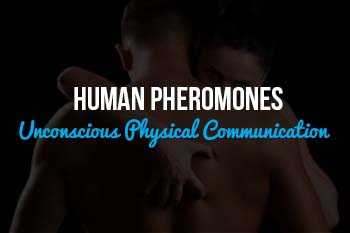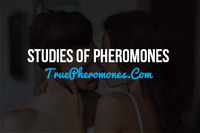Studies of Pheromones In Humans
9th Mar 2015
Human Pheromones - Unconscious Physical Communication
 Smell identification is commonly associated with the animal kingdom, similar to instincts and migratory patterns. However, as much as humans want to believe that pheromones don’t have a place in human physiology, the fact is they do.
Smell identification is commonly associated with the animal kingdom, similar to instincts and migratory patterns. However, as much as humans want to believe that pheromones don’t have a place in human physiology, the fact is they do.
Pheromones involve smells and scents that are generally produced by one animal and picked up by another of the same species. Once identified, the second animal tends to have some kind of reaction to the identified pheromone. A reaction can be in the form of attraction, aggression, or territory communication.
Humans, on the other hand, have long assumed pheromones don’t apply to them due to a lack of a heightened sense of smell to pick up the pheromone. While consciously most people may assume this is the fact, unconsciously a reaction is still actually occurring physically and deeper than the conscious, logical level.
Communication Receptors
Most mammals use their noses to track and identify various pheromones from other animals. Such smells take the job of communicating what humans would generally use words for. This includes attraction, mate selection, aggression and territory marking. While humans have a wide verbal vocabulary to make up for the lack of sticking a nose into someone else’s business, it’s also no surprise to those in the know why the perfume industry is a multi-billion dollar business. The fact is, humans still give off pheromones and use their noses in some fashion to determine cleanliness, attraction, acceptance, and mate selection.
 A rebuttal to this conclusion would be that instead of responding psychologically, humans live in a society that deems value to smelling good versus smelling natural. The body gives off multiple odors at any given time, due to bodily functions. These include eating, sweating, removing waste, and aging. Each activity has a different smell, most of what humans deem is offensive today. To either cover these up or temporarily remove them humans use products daily such as toothpaste, perfume, and cleaners as well as bathing. The result is a reduction of bacteria on the body’s surface which in turn removes or reduces the smell factor. However, the smells never permanently go away.
A rebuttal to this conclusion would be that instead of responding psychologically, humans live in a society that deems value to smelling good versus smelling natural. The body gives off multiple odors at any given time, due to bodily functions. These include eating, sweating, removing waste, and aging. Each activity has a different smell, most of what humans deem is offensive today. To either cover these up or temporarily remove them humans use products daily such as toothpaste, perfume, and cleaners as well as bathing. The result is a reduction of bacteria on the body’s surface which in turn removes or reduces the smell factor. However, the smells never permanently go away.
However, the cleaning need doesn’t explain why the human body is designed the way it is. In fact, in the areas of the body that produce the most smell, body hair is also more pronounced in humans. In animals, this is not very noticeable since most mammals are covered with fur. In humans, however, science leans towards the argument that the hair helps proliferate natural human body smell and pheromones.
Unfortunately, body smell and bacteria off-gassing are confused. The acidic smell people normally associated with a body is sweat. That smells comes from the waste the body gets rid of through sweat glands which bacteria then grows on. As bacteria becomes prominent, the “sweat” smell becomes apparent, triggering a psychological need in modern humans to take a shower, as trained in childhood. The pheromonal smell is actually a weaker, more subtle smell the body gives off as part of its identification system.
 The earliest studies on the existence of human pheromones generally include young children and mothers, but the basis started with animals studies first. In the human findings, many of the studies found a linkage between children and their particular parents that covered everything from personal family identification to gender consciousness. Even at a very young age of babyhood, children were able to use smell to correctly identify the clothes of their specific mothers rather than a stranger. The mid 1970s study found an apparent linkage between smell and the feeding response in the test babies when presented with the smell of their actual mother versus a stranger. Many a mother can also attest how their kids will cuddle a well-worn stuffed toy but will reject it after the toy has been cleaned and old smells removed.
The earliest studies on the existence of human pheromones generally include young children and mothers, but the basis started with animals studies first. In the human findings, many of the studies found a linkage between children and their particular parents that covered everything from personal family identification to gender consciousness. Even at a very young age of babyhood, children were able to use smell to correctly identify the clothes of their specific mothers rather than a stranger. The mid 1970s study found an apparent linkage between smell and the feeding response in the test babies when presented with the smell of their actual mother versus a stranger. Many a mother can also attest how their kids will cuddle a well-worn stuffed toy but will reject it after the toy has been cleaned and old smells removed.
Later studies expanded on sexuality and gender identification, using data ranging from historical physiological changes and when they occurred in proximity to the opposing gender to studies on odor perception and what is considered attractive versus offensive in later decades. Today, many a cosmetic company hires extensive staff just to find the right smells for products, which are known to increase sales significantly.
REFERENCES
CNN Health, “Study Finds Proof that Humans React to Pheromones,” March 1988. http://articles.cnn.com/1998-03-11/health/9803_11_pheromones_1_vomeronasal-organ-pheromones-researchers?_s=PM:HEALTH
Statistics Brain: Perfume Industry Statistics, March 2012. http://www.statisticbrain.com/perfume-industry-statistics
Handwerk, Brian, “Scent Secrets Unlocked, Artificial Noses Ahead?” National Geographic, February 2009. http://news.nationalgeographic.com/news/2009/02/090226-smell-science.html
Pines, Maya, , A Secret Sense in the Human Nose: Pheromones and Mammals, Howard Hughes Medical Institute. http://www.hhmi.org/senses/d230.html
McCabe, Meghan, “Do Human Pheromones Really Exist?” Serendip, February 2008. http://serendip.brynmawr.edu/exchange/node/2052
Cutler, Winnifred, Dr. “The Human Pheromone Discovery,” Athena Institute, http://www.athenainstitute.com/discovery.html

